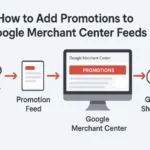
Google Shopping Ads can make or break your e-commerce success. They place your products right in front of high-intent shoppers. But running ads blindly is never enough. It’s important to monitor the performance of your Google Shopping Ads for maximum return on investment. In this blog, we discuss how to analyze Shopping Ads’ performance.
Key Metrics to Monitor in Google Shopping Ads
To start with, when viewing and analyzing your Google Shopping ads, you should make sure to understand the following metrics:
Click-Through Rate: A strong CTR shows that your product images and titles attract attention. If it’s below 1%, your ad may not appeal visually or contextually. To fix this:
- Use high-quality images.
- Add key specs in titles.
- Highlight USPs (free shipping, discounts).
Conversion Rate: This tells the user, in percentage, the number of people who will do the desired activity after clicking the ad, such as the example of buying the product. A low conversion rate signals:
- Pricing issues.
- Poor landing page design.
- Slow site speed or confusing checkout.
Cost Per Click (CPC): CPC is a metric designed to show how much customer acquisition costs the company on average. Lowering this number without hurting turnover is important for business purposes. If CPC is too high, you may want to:
- Narrow targeting.
- Reduce bids on low performers.
- Improve feed relevance.
High CPC with no conversions = wasted spend.
Impressions: Impressions tell you how often your ads appear. A low impression count could mean:
- Poor product feed optimization.
- Low bidding.
- Missing keywords or limited audience reach.
Google Shopping Ads Performance Analysis
To improve your ad performance, you need more than just launching campaigns. It’s important to dive into performance analysis using the right tools and strategies.
1. Use Feed to the Max
Your Google and YouTube Ads feed is the backbone of your campaigns. To evaluate and improve your feed effectively, focus on the following:
- Use relevant keywords: Boost product visibility by including high-intent and popular search terms in your titles and descriptions. This improves how your products appear in search results.
- Check for errors regularly: At least once a month, review your feed in Google Merchant Center. Look for issues like missing images, incorrect pricing, or disapproved items. Resolving these errors ensures your ads run smoothly without performance disruptions.
- Structure your feed by product category: Organize your feed based on product categories and monitor performance indicators for each group. This allows you to identify high-performing categories and spot those that need more attention and optimization.
2. Use a Google Shopping Feed app
Google Shopping feed apps like Wixpa help to manage and optimize effectively. These tools streamline your workflow and help improve overall campaign performance.
- Automated Updates: These apps make it easier to stay on top of product data. They update your feed automatically, so your pricing, stock, and product details are always current. That means fewer mistakes and fewer disapproved ads.
- Advanced Analytics: Many feed apps also offer built-in analytics. You can see which products are performing well and which ones need work.
3. Conduct regular performance reviews
To keep your Google Shopping Ads running effectively, it’s important to review their performance regularly. These reviews help you stay on track and adjust your strategy when needed.
- Schedule Audits: Regular audits help you spot performance drops early and act fast. Set a consistent review schedule, whether weekly or biweekly, based on the size and complexity of your campaigns.
- A/B Testing: Test different versions of key elements like titles, images, or pricing. Divide your products into two groups—A and B—and compare their results. Use what performs better to guide your ad improvements.
- Competitive Analysis: It is also very important to monitor your competition. Check out their advertisements and indicators. Identify gaps in their approach and take advantage of any missed opportunities in the market.
4. Leverage Insights to Improve Performance
Every analysis should help you make smarter decisions. Use what you learn to fine-tune your strategy and get better results from your Google Shopping Ads.
- Adjust Bids Strategically: If some products aren’t performing well, lower your bids to save budget. For high-performing items, consider increasing bids to boost visibility and conversions.
- Improve Landing Pages: If users are clicking but not buying, the problem might be the landing page. Review product pages for clarity, speed, and trust signals to help drive more sales.
- Refine Targeting: Use demographic and location data to focus your ads on the right audience. Smart targeting helps you reach the people most likely to buy.
Conclusion
Analyzing your Google Shopping Ads doesn’t have to be complicated. Start by understanding key performance metrics and using your product feed effectively. Tools like Google Shopping Feed apps can simplify the process and offer valuable insights. Regular monitoring helps you catch issues early and adjust your strategy as needed. With the right approach and consistent optimization, you can improve ad performance, increase your ROI, and stay competitive in the fast-moving e-commerce space.





